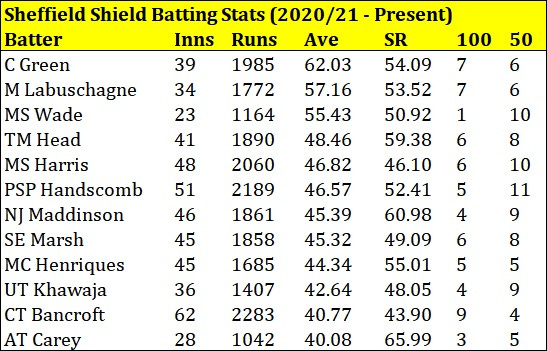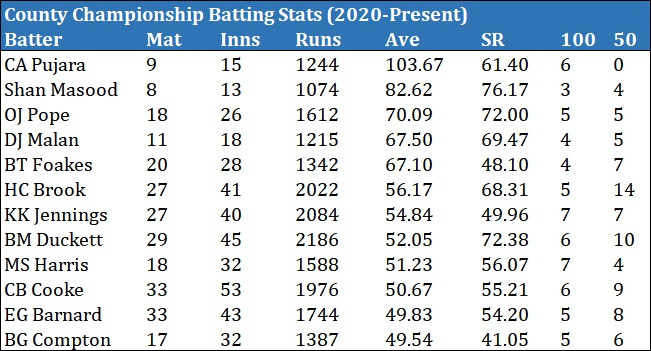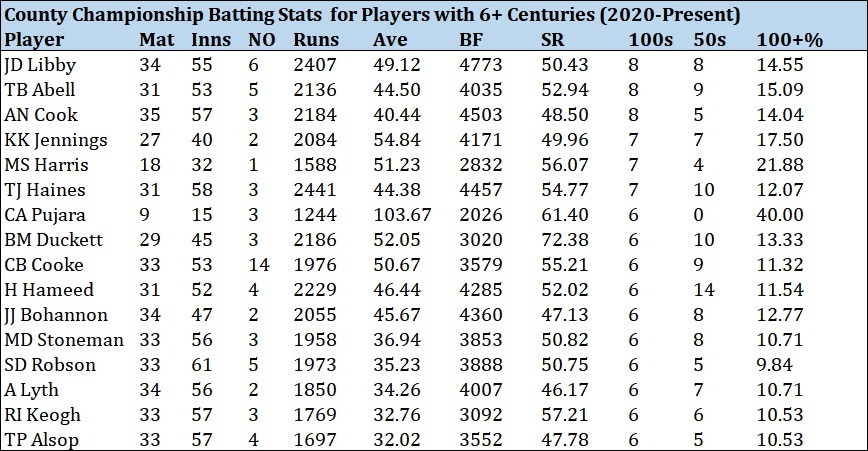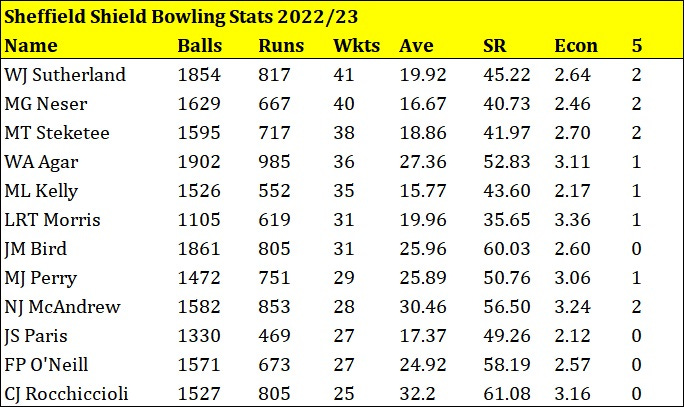The Australians are Coming (and half of them are already here)
Everywhere you looked over the first round of County Championship games it seemed as though there was an Aussie doing damage. Indeed, the round’s two highest scorers were both Australian, with Peter Handscomb’s 180 runs in Leicestershire's shock victory at Yorkshire bettered only by the 207 runs accumulated by Marcus Harris for Gloucestershire at Glamorgan.
Elsewhere, Nathan McAndrew, Sean Abbot, Matt Kuhnemann and Chris Tremain all bowled impressively, the latter two on their County débuts, with Tremain joined in this regard at Northants by keeper-batter Sam Whiteman. Cameron Bancroft and Peter Siddle both turned out for Somerset, whilst Marnus Labuschagne and Michael Neser will soon join Glamorgan for their third consecutive year at the club. Steve Smith will be joining Sussex in May and Lance Morris Northants in June. Essex were supposed to have Will Sutherland too, but he has had to pull out having suffered a long-term injury.
By any measure, this is a decent turnout, and one might immediately question how much of an impact the six Tests Australia are due to play in England this summer has had on these players’ openness to being recruited. In the case of Steve Smith, this is quite clearly the only reason he will be playing, but on the whole, an argument could be made that none of the others have been exclusively swayed by this.
Handscomb, Labuschagne, Neser, Siddle and Harris are all embarking on what is/will be their third consecutive year in the league and, whilst the upcoming Ashes series won’t have discouraged them in this, we may well have seen them playing anyway. Indeed, it is unlikely to have crossed the minds of Siddle and Labuschagne at all, Siddle having not played Test cricket for nearly three years and Labuschagne being one of the first names on the team sheet, whilst quite a few of the others who have signed up are quite far from the Test side at present; top players though they are, did Sam Whiteman, Nathan McAndrew or Chris Tremain really come here with the primary intention of breaking into the Ashes squad?
Looking back at recent seasons shows that there were actually more Australians playing in the Championship last season (although there is plenty of time for further signings to made later in the year) and last year was, if my memory serves me correctly, not an Ashes summer.
With all of this, it is difficult not to come to the conclusion that the majority of these players are here primarily to play County Championship cricket, exemplifying the pulling power that the league has.
Regardless of this conclusion however, there can be no doubt that almost all of the players listed here have at least half an eye on the Test matches, and, given that many of them are on the fringes of the squad, this adds an extra element of importance to the performances they put in over the next few months.
Amongst them, four played in Australia’s most recent Test Match, the fourth and final game of the Border-Gavaskar Trophy which finished last month; Marnus Labuschagne, Steve Smith, Peter Handscomb and Matthew Kuhnemann. Of these, only Smith and Labuschagne are certain to start in the World Test Championship Final in June (fitness permitting).
Matthew Kuhenmann played his three Test matches (all in this series) as one of three spinners, and remains behind both Nathan Lyon and Todd Murphy in the pecking order, despite taking an impressive 5-16 in the third Test. None-the-less, if he bowls something like as well as he did last week (match figures of 6-147 away at Sussex) for the next two months, then he may well become the next in line to Lyon, if the latter is injured or fails to perform early in the series.
Peter Handscomb made his return to the Test side in this series, having last played for Australia before this in January 2019. Although a capable wicket-keeper, he played in three of the four India Tests as a specialist batsmen (with Alex Carey taking the gloves for these games), but only averaged 29.00, passing 50 once in his 6 innings. Although far from terrible, especially on pitches which were notoriously tough going, these returns will not have made him an automatic pick and he has some work to do if he is ensure his maintains his place in the starting XI come June, especially if he is not down to be behind the stumps.
It is hard to argue with his recent domestic form though, with his recall coming off the back of a prolific 22/23 Sheffield Shield in which he scored 634 runs at 70.44 in the 10 innings he played before heading to India, hitting a career best 281* in the process. Since 2020, only Bancroft has scored more runs in the Shield than his 2189, and, of those players with 1000 or more runs, he has the sixth best average.
His record in England is less impressive across the same period, and he has only averaged 29.86 in the 23 innings he has batted here since 2020, a figure which was sitting at less than 24 before his match-winning contributions to Leicestershire’s extraordinary win over Yorkshire last week. Given that Australia’s next six Test matches are to be played in England, this overall record is unfortunate, although his runs at Headingley last week will have given him the best platform from which to rectify this over the next few months. As it stands, his 187 runs are good for second in the County Championship run charts, albeit after a single game. The good news for Australia is that the man who has bettered him is a compatriot, and, moreover, a compatriot who is likely to be very prominent in the selector’s minds: Marcus Harris.
Having become something of a Championship regular in recent years, Marcus Harris has as much experience in English conditions as any of his Aussie contemporaries. His record in these games is also extremely good: since 2020 he has 1588 Championship runs at an average of 51.23, with his tally of seven 100s bettered only by Jake Libby, Alastair Cook and Tom Abell (each with 8) - and equalled only by Tom Haines and Keaton Jennings. He has batted in eight fewer innings than the next lowest in what is a talented group, giving him the highest % of innings in which he has reached 100 of all of them.
In terms of average, he ranks in the top 10 for all players with a minimum of 1000 runs. All of those above him have played Test cricket, with all but one a current international (Keaton Jennings being the exception):
As figure 2 shows, his Sheffield Shield record is equally as impressive, but he begins to look like a potentially elite player when his figures from the two leagues are combined (this list also includes stats from the South African domestic 4 Day competition - but this only affects David Bedingham):
He leads the way in runs, 100s and 50s, and, although these were produced in more innings than the others, the fact that he is nearly 800 runs ahead of second spot is testament to his extraordinarily good form over the last three years or so. The questions then become, why hasn’t he been able to perform anywhere near to this in Test cricket? and, has his chance at becoming a Test batter come and gone and as a result?
His Test record is, after all, fairly underwhelming, marking him out as one of the countless highly talented opening batters who have struggled to make the jump up from First Class cricket. And yet, he has never really been given an extended run in the side; at least not by the standard of patience shown by England with some of their openers in recent times.
Since his last game for Australia in January 2022, the opportunity hasn’t really presented itself for a return, with Usman Khawaja having come in for the series away to Pakistan which followed it and has gone to score more runs and more 100s than any other Test opener in world cricket since. David Warner’s form, however, may well have just creaked open the door to let some light through for him, with all the signs that he is well and truly on the decline.
How long he will continue to preserve with Test match cricket whilst averaging under 30 remains to be seen, particularly as he remains a desirable (and expensive) T20 asset. It is reasonable to expect that he will be selected to start the first few Tests of this upcoming summer, particularly if Australia plan on fighting Bazball with Bazball. Should he struggle in the initial part of the series, however, there is a very real chance of him being dropped. Harris is almost certainly the next in line, although, at 31, this may well be his last opportunity to nail down his place in the side.
I say ‘almost certainly’, because there is some competition, notably from Cameron Bancroft, who has signed for Somerset until early May. Although he hasn’t played Test cricket since the 2019 Ashes, with his two games in that series the only games he has played since being hung out to dry by Smith, Warner et al during the ball-tampering scandal, he has gone on to score a lot of Shield runs in the intermittent period. Indeed, his 2283 runs and nine centuries are each league leading totals, albeit produced in a greater number of innings, and at a lower average, than the majority of those with whom he is competing against for a spot in the Australian side, including Marcus Harris.
Harris also has the advantage of having a far better First Class record in England, with Bancroft’s career 1830 Championship runs come at a 35.88, a respectable figure, although one that pales in comparison with Harris’.
Add to this Harris’ runs against Glamorgan last week, and it is clear that Bancroft has a lot of work over the next few games in order to overtake him in the pecking order ahead of the summer.
Whilst there is no guarantee that he will play, Harris should certainly be be named as part of the squad, although this applies to for a number of the Australians currently playing in the County Championship. Some of the pace bowlers, for example, have a very good chance of being named, even if only to fill out the touring party and provide some depth. With Josh Hazlewood’s recent injury struggles, there may even be an opportunity for some of them to get game time.
In Glamorgan’s Michael Neser, Australia have someone waiting in the wings who is highly unfortunate to have only played two Tests in his career. His career First Class bowling average of 23.44 (328 wickets) is clearly exceptional, but he has actually outperformed that over the last few years, 100 Shield wickets at 18.94 since the 2020/21 season. No-one else who has taken 40 or more wickets in the same period has an average below 20.
That 40 of these wickets came in 22/23 boosts his claim further, especially as they came at a staggeringly good, Sam Cook-esque, average of 16.67. His figures in England since 2020 have been more than acceptable too, with 60 wickets at 21.95 during his time in Cardiff. If all of this isn’t enough, he can also hold a bat, with a career batting average of 25.40 and 2 centuries suggesting him to me more than good enough to hold his own at eight in Tests cricket. During the research for this little section on him, I’ve become increasingly baffled as to why he has only played two Test matches, and have come to the conclusion that he is amongst the most under-rated red-ball cricketers to have played the game in recent times.
The other two pace bowlers of note are Sean Abbott and Lance Morris, although it is the latter of these whom I believe to have the best chance of international game time this summer. Whilst Abbott has played a few ODIs, and is certainly more experienced, Lance Morris is amongst the most exciting fast bowlers in world cricket. Capable of regularly bowling 90+mph, he, like Neser had a terrific Sheffield Shield this season, taking 31 wickets at 19.96, and at an elite level strike rate of 35.65. His pace makes him a potentially deadly weapon, and I wouldn’t be surprised if he is whipped out for a Test or two as a bit of a wildcard in the Ashes. But, if his time doesn’t come this year, it almost certainly will soon, and I expect him to play a lot of Test cricket over the next five or six years. In the meantime, he will make for essential viewing during his spell at Northants, which begins next month.
EXTRA STUFF
As a kind of appendix, here are the stats of every player to have faced/bowled 500 balls in both the County Championship and the Sheffield Shield, as well as the overall league averages, all followed by a brief analysis of the differences in run-scoring/wicket-taking environment.
Notes
On the whole, Australian cricketers perform better in Australia. Who’d have thought eh?
Wickets are worth slightly more, although VERY slightly more, in the Sheffield Shield.
Michael Neser should be a Test match cricketer.
The Sheffield Shield appears to be a more defensive league, with batter SRs and bowler economies lower across the board.
Did I mention about Michael Neser yet?



















